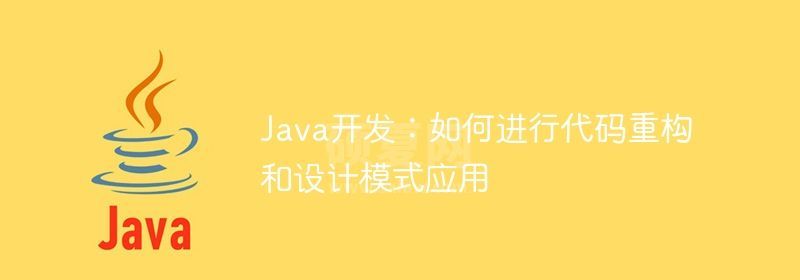Java开发:如何进行代码重构和设计模式应用

Java开发:如何进行代码重构和设计模式应用
在软件开发中,代码重构和设计模式的应用是提高代码质量和可维护性的重要手段。代码重构是指对已有代码进行结构、设计和性能的改善,而设计模式则是一种经过验证的解决问题的模板。本文将介绍如何进行代码重构和设计模式的应用,并给出具体的代码示例。
一、代码重构
- 提取方法(Extract Method)
提取方法是将一段重复的代码提取为一个独立的方法,用以增加代码的可读性和可维护性。例如,下面的代码在多个地方都有重复的逻辑:
public void printUserInfo(User user) {
System.out.println("Name: " + user.getName());
System.out.println("Age: " + user.getAge());
System.out.println("Email: " + user.getEmail());
}
public void printOrderInfo(Order order) {
System.out.println("Order ID: " + order.getId());
System.out.println("Order Date: " + order.getDate());
System.out.println("Order Total: " + order.getTotal());
}我们可以将这段重复的代码提取为一个独立的方法:
public void printInfo(String label, Printable printable) {
System.out.println(label + printable.getInfo());
}
public interface Printable {
String getInfo();
}
public class User implements Printable {
// ...
public String getInfo() {
return "Name: " + name + "
Age: " + age + "
Email: " + email;
}
}
public class Order implements Printable {
// ...
public String getInfo() {
return "Order ID: " + id + "
Order Date: " + date + "
Order Total: " + total;
}
}通过提取方法,我们可以减少代码的重复,并且更好地封装和复用逻辑。
- 合并重复的条件(Consolidate Conditional Expression)
当我们发现多个条件表达式中存在重复的逻辑时,可以将它们合并为一个更简单、更可读的表达式。例如,下面的代码存在重复的判断逻辑:
public double calculateDiscount(double price, int quantity) {
double discount = 0.0;
if (price > 100 && quantity > 5) {
discount = price * 0.1;
} else if (price > 200 && quantity > 10) {
discount = price * 0.2;
} else if (price > 300 && quantity > 15) {
discount = price * 0.3;
}
return discount;
}我们可以将这段重复的条件合并为一个更简单的表达式:
public double calculateDiscount(double price, int quantity) {
double discount = 0.0;
if (price > 300 && quantity > 15) {
discount = price * 0.3;
} else if (price > 200 && quantity > 10) {
discount = price * 0.2;
} else if (price > 100 && quantity > 5) {
discount = price * 0.1;
}
return discount;
}通过合并重复的条件,我们可以提高代码的可读性和维护性。
二、设计模式应用
- 单例模式(Singleton)
单例模式是一种保证一个类只有一个实例,并提供全局访问点的设计模式。在实际开发中,单例模式常用于管理共享资源、配置信息等。下面是一个简单的单例模式示例:
public class Singleton {
private static Singleton instance;
private Singleton() {}
public static Singleton getInstance() {
if (instance == null) {
synchronized (Singleton.class) {
if (instance == null) {
instance = new Singleton();
}
}
}
return instance;
}
}通过使用双重检查锁定机制,我们可以保证在多线程环境下创建唯一的实例。
- 工厂模式(Factory)
工厂模式是一种根据不同的参数来创建不同的对象的设计模式。在实际开发中,工厂模式常用于隐藏对象的创建逻辑,提供一致的接口来创建对象。下面是一个简单的工厂模式示例:
public interface Shape {
void draw();
}
public class Circle implements Shape {
public void draw() {
System.out.println("Drawing a circle.");
}
}
public class Rectangle implements Shape {
public void draw() {
System.out.println("Drawing a rectangle.");
}
}
public class ShapeFactory {
public static Shape createShape(String type) {
if (type.equals("circle")) {
return new Circle();
} else if (type.equals("rectangle")) {
return new Rectangle();
}
return null;
}
}通过使用工厂模式,我们可以解耦对象的创建和使用,增加代码的灵活性和可维护性。
总结:
代码重构和设计模式的应用是提高代码质量和可维护性的重要手段。通过合理地进行代码重构和应用设计模式,我们可以减少代码的重复,提高代码的可读性和可维护性。在实际开发中,我们还需要根据项目的实际情况和设计需求,选择合适的重构技术和设计模式来优化代码。
以上就是Java开发:如何进行代码重构和设计模式应用的详细内容,更多请关注其它相关文章!
